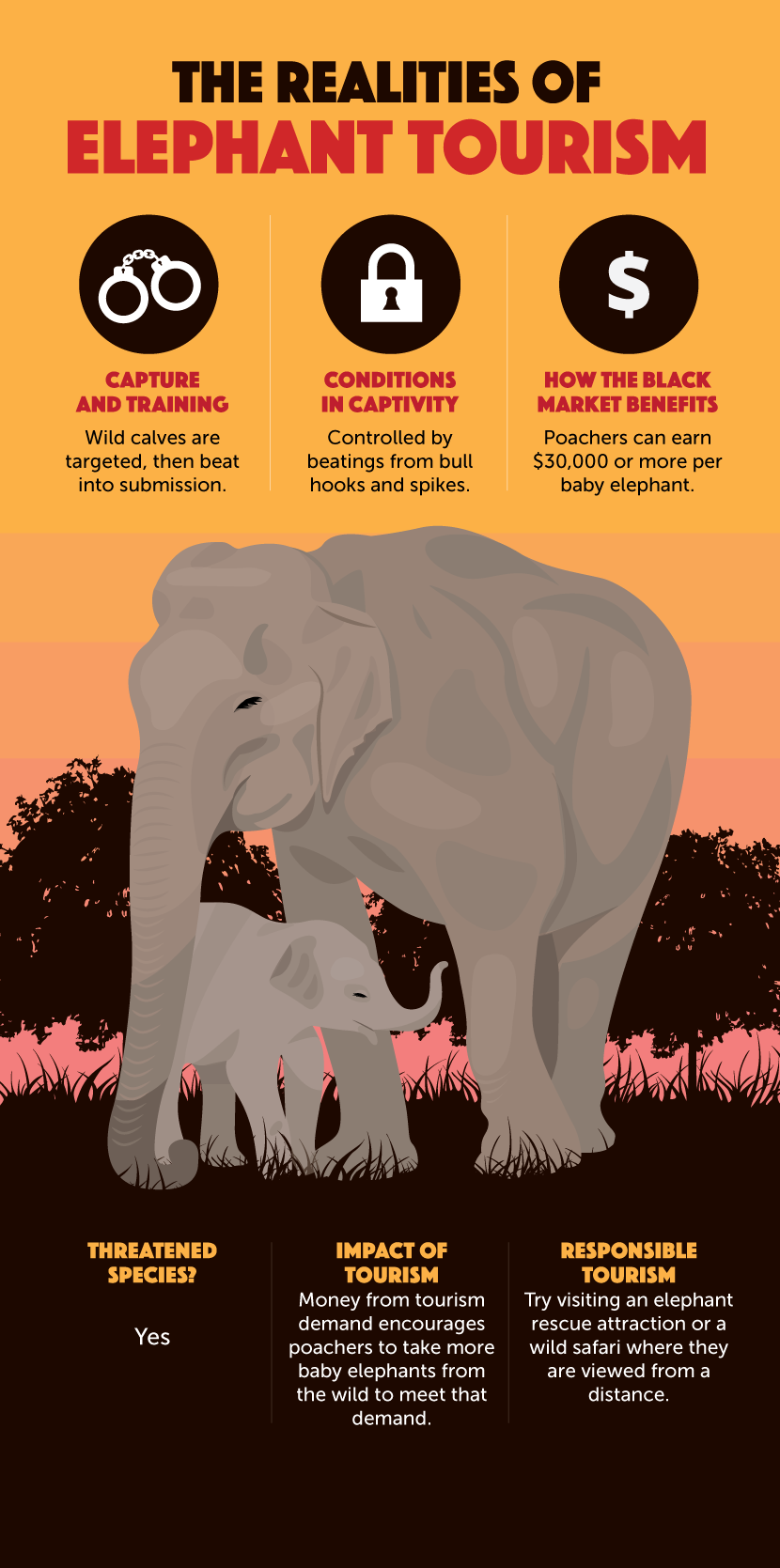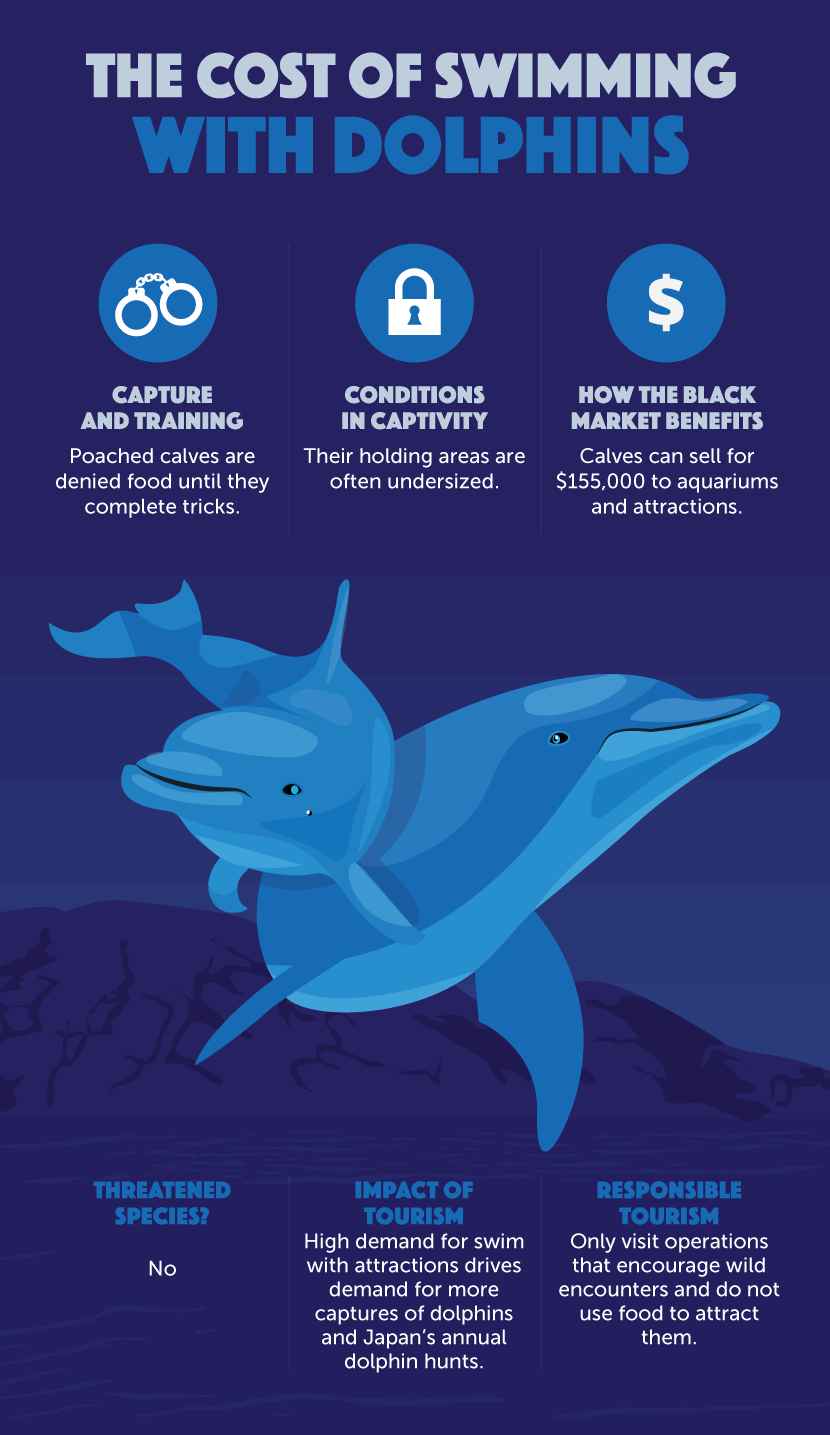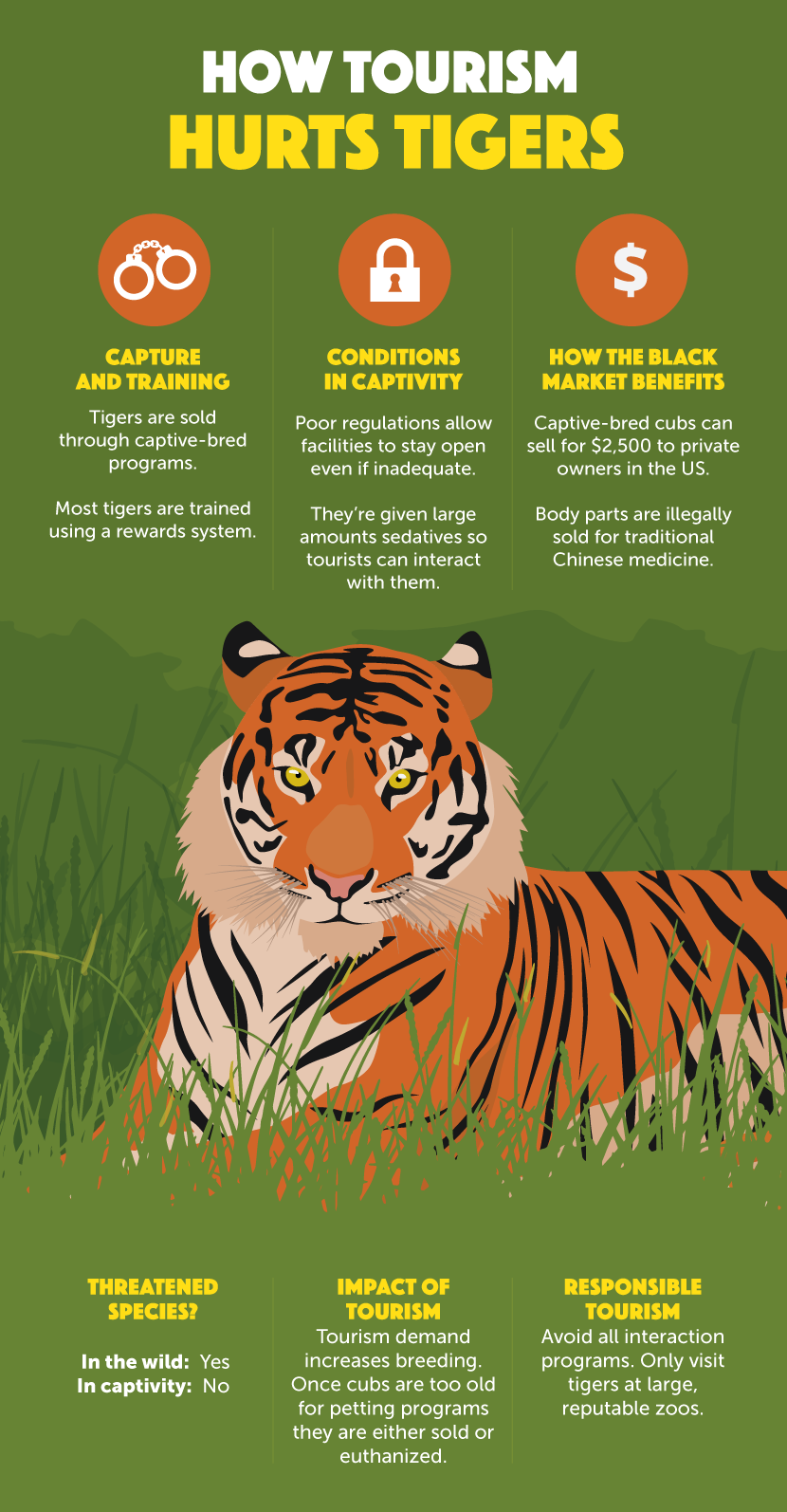The Dangers of Animal Tourism
What You're Really Paying For When You Visit Elephant, Dolphin, and Tiger Exhibits
Wildlife attractions come in all varieties. Everything from The Wildlife Conservation Society’s amazing zoos, which gives back so much to the environment to locally-owned mom-and-pop attractions. But what price are you really paying when you buy a ticket for an exhibit that allows you to interact with wildlife? How does one train a wild animal like an elephant to allow people to ride on it? Where did those dolphins come from that you are swimming with? Is it safe to let your child play with tigers?
In this article, we will take a closer look at some of the more popular animal interaction exhibits so you can better choose where to spend your money while on vacation.

Who wouldn’t love to ride an elephant? These gentle giants captivate us with their size and might. Our kids gawk at them, and for those of us that lived through the ‘80s, images of ourselves as Indiana Jones urge us to jump on their backs and brave the jungle. But how did this giant from far away find its way into a traveling show in my hometown? How did they teach it to act like a horse?
Elephants are a major tourist attraction everywhere. According to a United Nations survey, roughly 38% of the world’s elephant population is in domestic captivity. More incredibly, when you break that number down geographically, Myanmar, Thailand, and Laos actually have more domestic elephants than exist in their wilderness; Laos with the lowest ratio of only 350 wild elephants vs. 1,200 domestic. That same survey also notes that elephant breeding success in captivity is extremely low. When more domesticated elephants are needed, they are often captured from the wild population, thus depleting that population even more.
Elephants are born with no natural survival instincts. Their first 10 years of life are spent learning these skills from the other pack members. Elephants between the ages of three and six are the ideal candidates for trainers, and are sought-after by poachers who sell them into domestic service for roughly $30,000 a head. In order to separate the baby elephant from the rest of the pack, poachers first have to kill the other pack members before they can rope and cage their prey, often killing four to five adult elephants for every one baby they capture.
Once the baby elephant enters captivity, it is trained to obey commands using a tradition called “phajaan” or “the crush.” Elephants that are destined for tourist attractions and human interaction go through a longer period of phajaan, which can last several days to weeks. During this time, the elephants are steadily tortured to break their spirits. They are bound with chains, denied food and water, placed in cages where their legs and head are stretched to inflict pain, beaten with large metal bull hooks, and burned with flame or boiling water. After the torture ends, a new trainer (or mahout) is introduced to the elephant to play the role of “savior.” This trainer will release the animal from its stretching pen, speak to it in gentle tones, and bring it food and water in an effort to gain its trust.
The beatings can continue regularly, though, throughout the rest of the animal’s life whenever the handler feels it should be reminded who’s in control.
It should also be noted that an elephant’s brain is extremely complex. It’s been proven that they never forget these traumatic experiences, and due to the large size of their hippocampus, they will often experience mental flashbacks and exhibit post-traumatic stress disorder (PTSD). As a result of all this stress, it has been estimated that 5% of captive elephants have been responsible for a human death. This is only an estimate, though, since most elephant-related deaths in the Far East go unreported.

Dolphins are truly remarkable creatures. The common bottlenose dolphin can be found in most warm ocean waters around the world and the overall population numbers are good. There are currently two different methods of swimming with dolphins offered to tourists across the globe – wild swims and captive swims.
“Swimming with the dolphins” (SWTD) tourist attractions are controversial among animal rights groups. Many feel these highly intelligent creatures should not be caged or denied food by trainers in an effort to teach them tricks. On the other hand, it’s been found that after the casual tourist has a one-on-one encounter with a dolphin, it leaves them with stronger convictions about the need to protect the environment.
SWTD attractions are a relatively new industry. Consumer demand has skyrocketed for this industry in recent years, but still little is known about its full impact on both wild and captive dolphins.
Swimming with Wild dolphins:
Popular in Hawaii and Australia, this attraction involves tour operators bringing guests out to the open ocean in an attempt to locate a pod of wild dolphins. Operators that seek to have a minimum impact on the dolphins will gently position their boats into the path of an oncoming dolphin pod, not using food or any other means to attract the dolphins, and then let the swimmers enter the water. This is the best scenario for having a minimum impact on the dolphins. It allows the dolphins to use their natural curiosity to come into close contact with the swimmers.
Swimming with Captive dolphins:
This is the more controversial method of SWTD. Dolphins are captured in the wild during large hunts, held in a range of pen types from large open-water netted-off coves to smaller concrete pool structures. Popular at cruise ship destinations like the Caribbean and at inland marine attraction theme parks, the guests are guaranteed close physical contact with trained dolphins. Keep in mind, though, that most of these dolphins were not born in captivity, are not “rescue” animals, and are there to make the park owners money. A well-trained dolphin here will net $2,000–$3,000 a day for the park and may be covered by a life insurance policy of up to $5 million.
Animal rights groups often accuse operations like these of “greenwashing.” This is the process of using PR and marketing to make them look more environmentally focused than they really are. In one case, the now-closed Marineland of Napier, New Zealand, funded a study through the local Massey University that in 2002 concluded, “There is no outward evidence of poor welfare in the dolphins’ response to swimmers.” Yet in 2008 one of the show’s dolphins died from stomach cancer, which ultimately led to the park’s closure. The dolphin had a tumor the size of a mandarin orange in its stomach that went unnoticed. The manager of this facility was also found guilty of falsifying paperwork regarding the park’s wild seal pups.

It is estimated that in the United States alone there are over 5,000 tigers in captivity, yet just 3,200 wild tigers roam their native ranges in Asia today. Tigers breed easily in captivity and are a popular tourist attraction across the globe. Many of these attractions offer visitors the chance to play with tiger cubs, feed fully-grown tigers, or have their photo taken with a leashed tiger that has been drugged.
Facilities like these have also come under fire for greenwashing their marketing messages. They rarely help protect wild populations – most of the animals are part of a breeding program or are simply there to generate money for the owners. Baby tigers sell for $2,500 to private owners in the United States. Currently, it is legal to own a tiger as a pet in 20 states, and in six states no permitting is required at all.
Since there are no or few regulations on this industry it is hard to say if you are patronizing a reputable facility or not. In 2016, the USDA charged a non-profit organization, “Wildlife In Need” in Charlestown, Indiana, with 118 counts of violating the Animal Care Act. Among the charges were that the park owner euthanized a young leopard by beating it with a baseball bat, physically beat a tiger cub to discipline it for biting a customer’s clothing during “Tiger Baby Playtime,” and allowed a leopard to escape the facility, which then killed a local resident.
Another startling event in 2016 was the permanent shut-down of the world’s largest tiger facility. The “Tiger Temple” in Thailand was founded and run by Buddhist monks under the guise of protecting wild tigers. A police raid found that the monks were illegally breeding tigers and killing the cubs to sell on the black market. Tiger parts are popular in some traditional Chinese medicines.
Where you choose to spend your hard-earned dollars is ultimately your choice. But be aware that there are places that try to con you into believing your dollars are going to a worthy cause. Just because a facility operates as a non-profit does not mean the owners cannot keep 100% of the money generated by the attraction. In the end, you might be supporting a venue that contributes to the illegal animal trade, supports animal abuse, or puts your life in danger through interactions with dangerous animals.
Sources
- Gone Astray – The Care and Management of the Asian Elephant in Domesticity
Richard C. Lair
- Food and Agriculture Organization of the United Nations(FAO)
Forestry Department, Rome, Italy and Forestry Department Group, Regional Office for Asia and the Pacific (RAP)
- Controlling Elephants
Embed the article on your site

